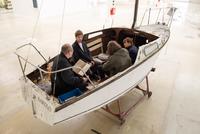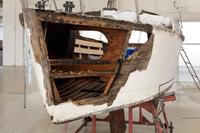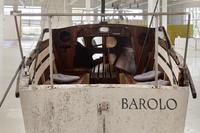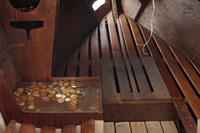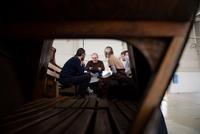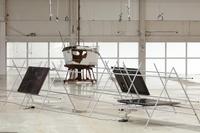Jan Boháč & Viktor Dedek: Skeleton. Episode Two of the Euromedieval Saga
←→
We sat at an elmwood table set in a branchy yew tree. Honza was translating a manuscript about the Druids and I was filling out my first tax return. The company I was delivering food for during lockdown is based in Denmark, so I guess I’m liable for VAT or something. In the Druidic teaching, the yew is associated with death and resurrection. That’s why its wood is often used to make weapons.
The deathly light of the full moon was falling over the Prague Nine city district and the fridge was chilling with all its might all the wine left over from the exhibition opening. We had drunk many a glass when something else caught our attention. Our gaze fell on several large stones lying under the yew tree. † Pepíček the parrot, October 25, 1995; † Zuzanka, April 4, 2002; † Zuzi 2 the rosy-faced, April 19, 2002; † Pepík, June 6, 2002. When I saw a greenish light under the yew tree coming from the other side of the garden, I crept closer and jumped up onto a branch. Two almost identical skeleton hamsters were arranging pebbles in a kind of ecstatic concentration on a floor plan drawn on the table. A parrot moved around the edge, squeaking its beak, shaking and rattling its bones as if protecting the table with this ritual dance, while two human skeletons traced Druidic runes on the 2020 tax return. A trickle of rosé wine ran through their empty bodies from time to time. There were five of them. They were preparing an exhibition. Loss of muscle through education, ossification through bureaucracy, emptying through mannerism, the death of meaning before it has been revealed. We gathered, the five of us necromancers, to give reality a second life – and oh, what a life: the green light will easily stir the tax haven sand-clogged bones of Brussels, illuminate the stubborn skull of the Czech art scene, and break the chains over the chicken graves of shopping malls fast-food.
One of the basic motifs of Dragon’s Lair, the Czech version of the RPG (Role-Playing-Game) Dungeons & Dragons, are ruins. They are a harbinger of danger and often become a lair for various monsters or a refuge for those who need to hide. The Dragon’s Lair is basically set in a fantasy world, but the possibilities for RPGs are unlimited – from historical re-enactments to completely abstract worlds of other forms and laws. In the context of contemporary gender issues, the imaginative and fictional nature of the game allows for free permeability, enabling the creation of a whole spectrum of environments – from totally discriminatory to utopian-like tolerant. An important element is the setting of the game situation, i.e. where the game is actually played. Minimalist demand on game resources is undoubtedly an advantage of the game (a pencil, paper and a die will do), but further elaboration of the environment where the player sits can enhance immersion on the one hand, and on the other make the game experience more connected to the reality outside the game.
Jan Boháč a Viktor Dedek
The key elements in the practice of Jan Boháč are creative collaboration, the combination of dramatic and sculptural forms and the subjects of fate, distress and uncertainty. He often uses methods of collective story development and speculative scenarios. He is a graduate of the Sculpture Studio at the Academy of Architecture, Art and Design (AAAD, Prague); since 2017 he has been continuing his postgraduate studies there. He is also a professional emergency line paramedic. He exhibits his work in the Czech Republic and abroad. Jan Boháč designs sculptural environments for special scenarios and narratives – announcements, emergency connections, remote broadcasts. The material stage in them is both a witness to and a victim of an event with fatal consequences. The event shows all the hallmarks of ‘drama’: it is emotionally transformative, shaping its actors, and the narration style is driven by the interdependence of co-actors and improvisation under pressure. The result then logically resembles theatrical, radio and film formats.
Viktor Dedek graduated in 2020 from the Sculpture Studio of the AAAD in Prague. He completed internships at the Universität für Angewandte Kunst in Vienna and the Zürcher Hochschule der Künste in Zurich. He also studied in the studio of Tomáš Vaněk at the Academy of Fine Arts in Prague and in the studio of guest artist Marie de Brugerolle at the AAAD. His work has continuously been dedicated to the interconnected relationship between the following areas: the game world, game environments, art installations, performance, literature, reality and fiction. He compares the economies and politics of art and the game world and the figures of the artist and the player. Exploring game systems, game architecture, and the method of literary writing, he develops – through a critique of reductive tendencies in the knowledge of the world and through a rejection of dominant narratives and categorizations – a method of preserving complexity.
Special thanks to the Ministry of Culture of the Czech Republic and Moravian-Silesian Region.
